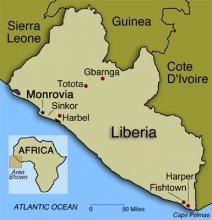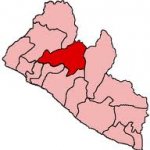Regional Background
Liberia is the oldest republic in Africa with a relatively small population, sixteen ethnic groups and fifteen political sub divisions or counties. Its foundation started with the resettlement of freed slaves from America by the American Colonization Society. A group that saw slavery as a bad practice from different points of view, religious, political, legal etc. The group constituted politicians, clergymen, lawyers and people from different spectrums of society. Though there were tribal settlements and kingdoms in Liberia before the coming of the freed slaves from America, Liberia was actually established through the joint efforts of the settlers who are also referred to as Americo Liberians or congors and their African hosts. It is worth mentioning that the settlers, inspired by the desire to have a state of their own in their land of nativity, Africa, took the lead in founding the Liberian state. Their link with the US is reflected in the social and political structures they established. The kind government they established was mainly western, in fact American in style. The flag is not just red, white and blue in color but designed like the American flag. They laid the foundation for western education and governance but are generally believed to have defaulted on the democratic principles of equal opportunity and popular participation of people in Government.The dark-skinned settlers complained that the American Colonization Society gave preferential treatments to the mulattoes. But tension between them and their African hosts was more attention calling. There were almost always tension between the settlers and the Africans over land and authority. This divided the country into two major political and social enclaves: the natives or indigenous and Americo Liberians. There was a single Americo-Liberian political party at some point that ruled for more than one hundred years. There was huge resentment among the natives for their exclusion from the governance of their own country. In 1979, there was a popular uprising against the Tolbert led government for increasing the price of rice. The street protest which was led by highly educated sons and daughters of native or indigenous Liberians degenerated into a violent riot that cost many lives and some key actors going to prison. This protest was a message that they were tired of the century old rule of the True Whig Party that had marginalized the indigenous and had widened the gap between the haves and have-nots. All of this dissatisfaction culminated into a bloody coup d’état that saw the death of President Tolbert who was believed to be the most moderate and unifying Americo-Liberian leader. Now that the Americo Liberians were out of power and the natives were in control, it was anticipated that there would a dramatic change in the livelihood of the power for the people celebrated the coup in many quarters. Things turned to be even worst in the areas of human rights abuses and the very corruption that was be address. In late 1989, a rebel group led by an Americo Liberia Charles Taylor marched upon the country to battle President Doe out of power. This led to several years of civil war that caused thousands including my family and me to flee into neighboring Ivory Coast. There were other political and tribal wars fought intermittently before Liberia started to finally enjoy peace again. We hope and pray that this peace is further consolidating through the efforts of all national political, economic and religious key players.
Regional Background
One of Liberia’s sixteen counties is Bong, the host of the Children of the Earth Spirit Youth Hub. It is a centrally and strategically located county and has a population of about 350,000 people, making it the third most populated county. It is peopled mainly by Christians, Muslims and Traditionalists or otherwise African religionists. The principal language is Kpelle, even though Mandingo is widely spoken owing to the large Mandingo population in the area. The soil here is extremely fertile and so more people especially rural dwellers are farmers. They grow food mainly at the subsistent level due to their used of traditional methods of farming. This contributes to the very low production to locally consume food in spite of the rich soil. It is also important to note that a significant fraction of farm land is farmed with rubber, which is a more lucrative venture than much other agriculture activities here in Liberia. However, Bong County does not just have a farming profile. It has a very controversial economic, political and military history. The principal city of the county, Gbarnga, was earmarked by former Liberian president William R. Tolbert as an ideal alternative if the National capital were to be relocated into the hinterland as was being discussed. His preferment of Gbarnga was probably due to its central and all-connecting location that facilitates trade between counties and between them and Monrovia. It is also well placed in a chain of cities (Ganta, Gbarnga, and Kakata) that connect Monrovia to other neighboring Cote d’Ivoire and Guinea.
Bong County is blessed with several renowned educational institutions. The Cuttington University, arguably the national premium university, is located in Suacoco, Bong County. The Konola Mission, a nationally acclaimed boarding secondary school is in Bong County. The St. Martin’s Catholic High School, Methodist and Gboveh High schools are some of the best high schools in the county. These Bong-based institutions have produced hundreds of past and present senior government officials, business entrepreneurs and civil society leaders that have contributed or are still contributing to the economic and social development of Liberia.






